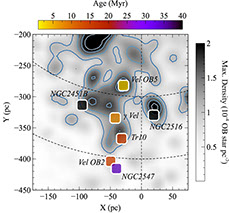Cosmography of massive stars in the solar neighborhood
Massive stars live shortly — 100 Myr at most — and are therefore excellent tracers of recent star formation activity. Using the 25 years old Hipparcos catalogue, my collaborator João Alves at the University of Vienna and I studied the spatial distribution of massive OB stars in the solar neighborhood, up to approximately 500pc. While previous studies were based on 2D projections of the spatial and velocity distributions, we decided to use modern data mining and full 3-D visualization techniques to look at the distribution of massive stars in 3-D.
The interactive figure below shows the 3-D spatial density of massive stars computed in our analysis. This new way of treating the data has offered new insights into the distribution of nearby stars and uncovered new groupings of stars in the solar neighbourhood, shedding light on the origins of the stars in Orion and calling into question the existence of the Gould Belt – an iconic ring-shaped structure of stars in the Milky Way.
The figures below immediately shows that the solar neighbourhood is dominated by three huge stream-like galactic structures made up of dense clusters and loose associations of young, blue, O and B type stars. These contain several tens of O and B type stars, most of the local well-known clusters, and some previously unreported stellar groups. The first structure runs from the constellation Scorpius to the constellation Canis Majoris covering more than 1100 light years and at least 65 million years of star formation history. The second, located in the constellation Vela, covers at least 500 light years and 30 million years of history. Although all three of the newly discovered streams have a story to tell, it is the third structure, located in the constellation Orion, that is perhaps the most significant due to its mystery-solving qualities.



The Orion Blue Stream
The Scorpius-Canis Majoris Stream
The Vela Blue Stream
<
>
The origin of the blue supergiants that define the body and belt of the Orion constellation has long been a mystery. The five giant O and B type stars are located between around 250 and 800 light years from Earth and as a result it was assumed that their origin was not, despite their name, in the prolific Orion Nebula star-forming region, which lies around 1300 light years from Earth. However, the discovery of the Orion stream offers a simple solution. It implies that these relatively distant populations are in fact linked as part of a large galactic structure, which spans more than 1000 light years and at least 25 million years of star formation history.
One exciting find from this study relates to Betelgeuse, the red giant in the arm of Orion. The origin of this star has always been shrouded in mystery but through this study we have uncovered a new loosely organised group – or OB association – named Taurion which we believe to be Betelgeuse's birthplace and to contain its sibling stars.
Link to the European Space Agency Press Release.
Link to the full article published in Astronomy & Astrophysics
The 3D data weight 6.6MB and might take some time to load, depending on your connection...
The figure below is interactive.
Drag your mouse to rotate the map. Use the mouse wheel or middle button to zoom. Use the following buttons to toggle on/off elements.

You must enable Javascript to view this page properly.
© Last Update: 13-02-2017 by H. Bouy
Photograph Credit: Yuri Beletsky